What Can You Watch Through Binoculars?
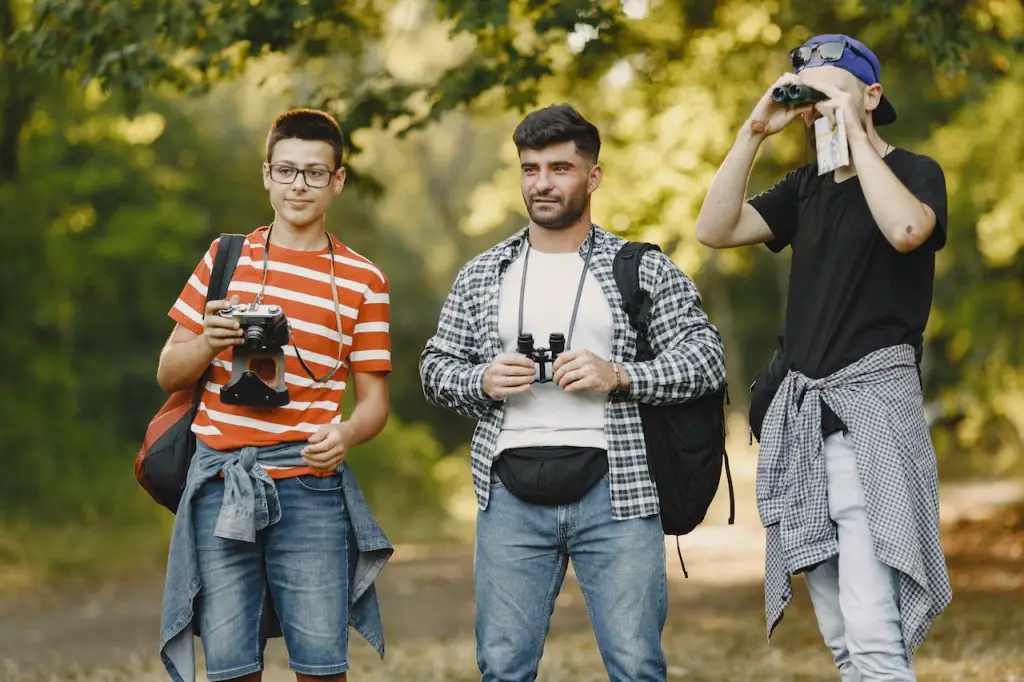
Have you ever wondered what you can see through a pair of binoculars?
These amazing devices have the power to unveil a world of wonders that are otherwise unseen by the naked eye.
Whether you’re a beginner or experienced, binoculars offer a window into fascinating activities and breathtaking sights.
With binoculars, you can observe everything from birds in flight and wildlife in their natural habitats to stunning landscapes and even the stars above.
Imagine getting up close and personal with colorful birds, spotting elusive animals, or witnessing the intricate details of distant mountains and landmarks. The possibilities are endless!
In this article, we’ll delve into the exciting activities that await you through the lens of binoculars.
We’ll explore the realms of birdwatching, wildlife observation, stargazing, sports events, marine activities, and more.
Get ready to unlock a whole new level of exploration and sail on incredible journeys with just a simple pair of binoculars.
List of Activities You Can Do With Binoculars
- Bird Watching
- Wildlife Observation
- Stargazing and Astronomy
- Sporting Events and Concerts
- Marine and Coastal Activities
- Air Shows and Planespotting
- Nature Photography
- Landscape and Scenic Views
Let’s see in detail what you can watch and discover through this wonderful equipment.
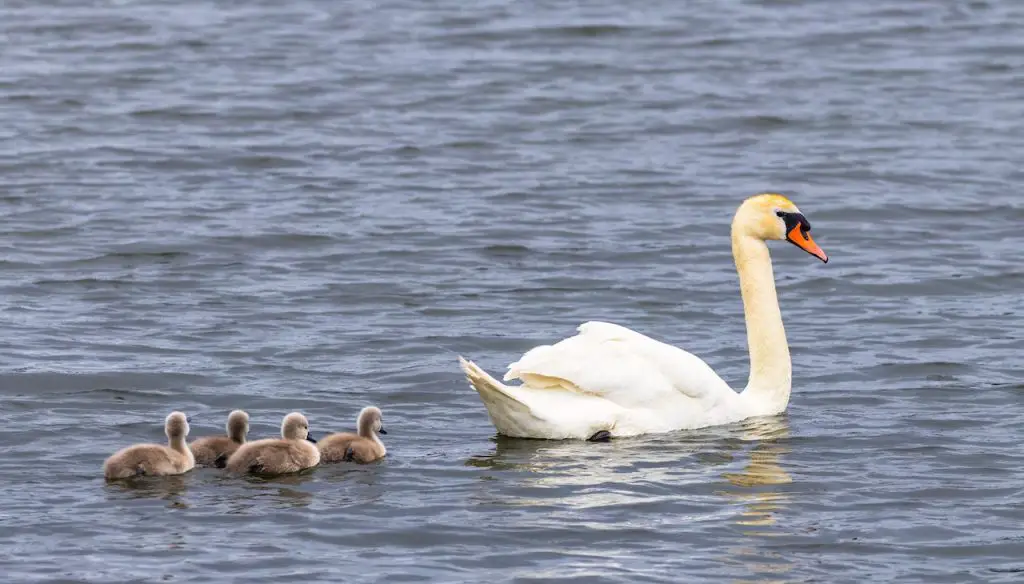
Bird Watching
Bird watching offers a unique opportunity to appreciate the beauty and diversity of avian species, as well as to study their behavior and habitats.
Binoculars play a crucial role in enhancing the birding experience, allowing enthusiasts to get closer views of birds that are often distant or high up in trees.
Various Bird species to watch through binoculars
From colorful songbirds to majestic birds of prey, there is an incredible diversity of birds to watch through binoculars.
Some popular bird species that bird watchers often seek include:
- Bald Eagle: With its impressive wingspan and striking white head, the bald eagle is a majestic sight. Observing these powerful birds in flight or perched on treetops is a thrilling experience.
- Hummingbirds: These tiny, fast-flying birds are known for their vibrant colors and unique hovering flight. Watching hummingbirds darting from flower to flower is a delight for bird watchers.
- Woodpeckers: Woodpeckers are known for their rhythmic drumming on tree trunks and distinctive plumage. Spotting a woodpecker using its beak to excavate a tree or listening to its drumming sounds is an exciting encounter.
- Owls: Owls are nocturnal birds known for their exceptional hunting abilities and mysterious demeanor. Observing an owl silently gliding through the night or perched on a branch is a memorable experience.
- Warblers: Warblers are small, colorful songbirds that often migrate long distances. These birds are a treat to observe during their breeding season when they showcase their vibrant plumage and melodious songs.
Types Of binoculars suitable for bird watching
When it comes to bird watching, choosing the right binoculars is essential for capturing clear and detailed views of birds in their natural habitats.
Here are some factors to consider when selecting binoculars for bird watching:
- Magnification: Opt for binoculars with magnification in the range of 8x to 10x. Higher magnification might result in a narrower field of view, making it difficult to track birds in flight.
- Objective Lens Diameter: A larger objective lens diameter (around 42mm) allows more light to enter, resulting in brighter images, especially in low-light conditions.
- Field of View: A wider field of view enables you to observe birds in their surroundings without constantly adjusting the binoculars. Look for binoculars with a wide field of view, typically measured in feet at a thousand yards.
- Close Focus Distance: Birds can often be found at relatively close distances. Choosing binoculars with a close focus distance of 6 to 10 feet allows for detailed observation of birds nearby.
- Weight and Portability: Since bird watching involves extended periods of observation, lightweight and portable binoculars are recommended for comfortable use during long outings.
- Image Quality: Consider binoculars with good optics, including high-quality glass and lens coatings, to ensure sharp and clear images with accurate color rendition.
One highly recommended binocular for bird watching is the Nikon Monarch 7 8×42 Binoculars. This binocular offers excellent optical performance and durability, making it a favourite among bird watchers.
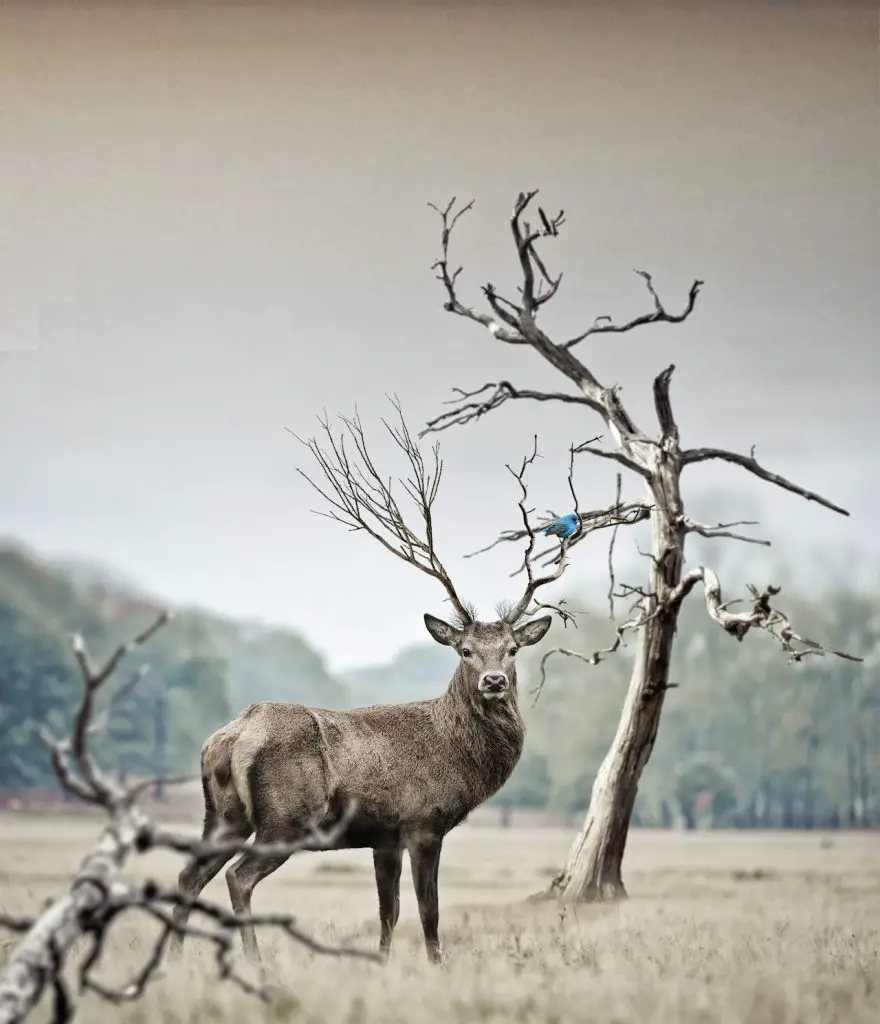
Wildlife Observation
With binoculars, wildlife enthusiasts can get a closer look at animals without disturbing or endangering them.
Wildlife observation offers a chance to deepen our understanding and appreciation of the natural world while promoting conservation efforts.
Here are some notable animals to observe using binoculars:
- Big Cats: Majestic big cats, such as lions, tigers, leopards, and cheetahs, are some of the most sought-after animals to observe in the wild. Binoculars allow you to witness their powerful movements, hunting strategies, and social dynamics from a safe distance.
- Elephants: Observing elephants in their natural habitats provides a glimpse into their intricate family structures, protective behaviors, and their awe-inspiring size. Binoculars help capture the subtle details of their interactions and expressions.
- Birds of Prey: Binoculars offer an excellent way to appreciate birds of prey, including eagles, hawks, and falcons. Observing their graceful flight, hunting techniques, and nest-building activities provides a unique insight into their lives.
- Marine Life: From whales and dolphins to sea turtles and seals, marine life offers captivating wildlife observation opportunities. Binoculars enable you to observe these creatures from shorelines or boats, witnessing their underwater acrobatics and interactions.
- Primates: Observing primates, such as gorillas, chimpanzees, and orangutans, through binoculars provides a glimpse into their complex social structures, communication methods, and their striking resemblance to humans.
Choosing binoculars for wildlife observation
When selecting binoculars for wildlife observation, several factors should be considered to ensure an optimal viewing experience.
Here are some features to look for:
- Magnification: Opt for binoculars with magnification ranging from 8x to 10x. This range strikes a good balance between bringing animals closer and maintaining a steady image.
- Objective Lens Diameter: A larger objective lens diameter (around 42mm) allows more light to enter the binoculars, resulting in brighter images, especially in low-light conditions.
- Field of View: Choose binoculars with a wide field of view, typically measured in feet at a thousand yards. A wider field of view enables you to observe animals in their surroundings without constantly adjusting the binoculars.
- Durability and Weather Resistance: Since wildlife observation often involves outdoor adventures, opt for binoculars that are rugged, waterproof, and resistant to fog. These features ensure that your binoculars can withstand various weather conditions and environments.
One highly recommended binocular for wildlife observation is the Vortex Optics Diamondback HD 10×42 Binoculars.
These binoculars offer exceptional optical performance and durability, making them ideal for wildlife enthusiasts.
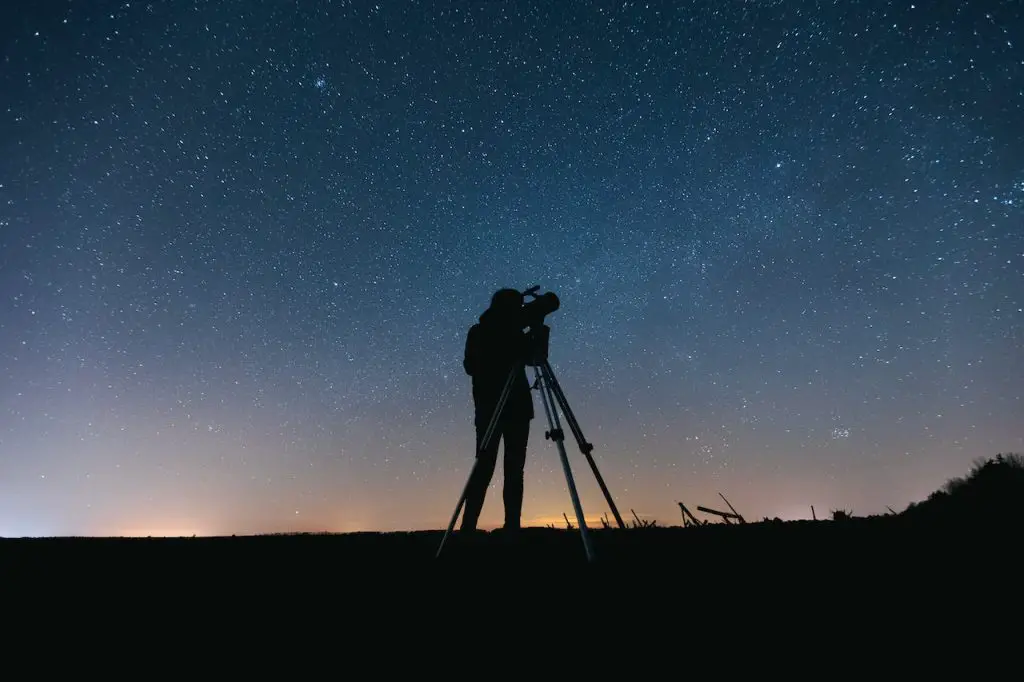
Stargazing and Astronomy
Stargazing is a fascinating and awe-inspiring activity that allows us to explore the vastness of the universe.
With the help of binoculars, both amateur and seasoned astronomers can delve into the wonders of the night sky.
Stargazing and astronomy offer a chance to observe celestial objects, study their movements, and unravel the mysteries of our universe.
Celestial objects to observe with binoculars
While telescopes are commonly used for astronomy, binoculars can provide a wider field of view, making them perfect for observing larger astronomical phenomena.
Here are some celestial objects that are particularly well-suited for observation with binoculars:
- Moon: The moon’s craters, mountains, and dark lunar seas (maria) offer a rich landscape for observation. Binoculars allow for detailed views of the moon’s surface, revealing intricate features.
- Planets: Binoculars can provide remarkable views of bright planets like Jupiter, Saturn, and Mars. With good viewing conditions, you may be able to spot Jupiter’s moons, Saturn’s rings, and the reddish hue of Mars.
- Star Clusters: Binoculars excel at capturing the beauty of star clusters, such as the Pleiades (Seven Sisters) and the Beehive Cluster (Messier 44). These clusters appear as groups of stars tightly packed together, creating stunning visual displays.
- Nebulae: Certain nebulae, such as the Orion Nebula (Messier 42), can be observed with binoculars. These interstellar clouds of gas and dust often exhibit intricate patterns and colors, providing a captivating sight.
- Meteor Showers: Binoculars can enhance the experience of meteor showers by allowing you to see more shooting stars and appreciate their trails across the sky.
An Interesting Video: Space Watching
Optimal Binocular Specifications For Stargazing
When selecting binoculars for stargazing, certain specifications and features are important to consider. Here are some optimal binocular specifications for stargazing:
- Magnification: Opt for binoculars with a lower magnification, typically between 10x and 25x. However, Higher magnifications can make it difficult to keep the image steady due to hand movements. Using a Tripod can be helpful in case of higher magnifications.
- Objective Lens Diameter: Choose binoculars with a larger objective lens diameter, typically around 42mm or larger. This allows for better light-gathering capability, resulting in brighter and clearer views.
- Exit Pupil: Look for binoculars with a larger exit pupil diameter, which is calculated by dividing the objective lens diameter by the magnification. A larger exit pupil (around 5mm) ensures brighter images in low-light conditions.
- Field of View: Consider binoculars with a wider field of view to capture larger sections of the night sky. A wider field of view enables easier navigation and tracking of celestial objects.
One highly recommended binocular for stargazing is the Celestron SkyMaster 25×70 Binoculars. These binoculars offer excellent performance and are specifically designed for astronomical observation.

Sporting Events and Concerts
Enhancing the viewing experience at sports events and concerts while Attending these events live can be thrilling, but sometimes the action can be distant or obscured from your seat.
Binoculars offer a solution by bringing the action closer and enhancing your viewing experience.
Whether you’re watching a soccer match, a football game, or a music concert, binoculars provide a clearer and more detailed view of the performers or athletes, allowing you to feel more engaged and immersed in the event.
Performances and activities to watch through binoculars
Binoculars can enhance the enjoyment of various performances and activities at sports events and concerts.
Here are some notable examples:
- Sporting Events: Binoculars enable you to closely follow the movements of athletes during a sporting event, such as watching a soccer player dribble the ball or observing a baseball player’s pitching technique. You can also observe the interactions between players and catch details that might be missed by the naked eye.
- Concerts: Using binoculars at concerts allows you to see the facial expressions and gestures of performers on stage, making you feel more connected to their artistry. You can also appreciate the details of their instruments and observe the dynamics between band members.
- Dance Performances: Binoculars can enhance the viewing experience at dance performances, allowing you to observe the intricate choreography, facial expressions, and the fluid movements of the dancers. You can appreciate the details of their costumes and catch subtle nuances that might be missed from a distance.
- Motor Sports: Binoculars are especially valuable for observing motor sports events, such as Formula 1 races or motorcycle races. With binoculars, you can track the high-speed action on the track, observe pit stops, and appreciate the maneuvers and strategies of the drivers.
Binocular features suitable for events and concerts
When choosing binoculars for sporting events and concerts, consider the following features:
- Compact and Lightweight: Opt for compact and lightweight binoculars that are easy to carry and hold for extended periods. This ensures comfort and convenience during long events.
- Wide Field of View: Select binoculars with a wide field of view, allowing you to capture more of the action without constantly adjusting the binoculars. This is particularly useful for tracking fast-paced events.
- Image Stability: Look for binoculars with image stabilization technology or higher magnification with built-in image stability features. This helps reduce hand movements and ensures a steadier image, especially for concerts and events where you might not have the luxury of a tripod.
- Durability: Opt for binoculars that are built to withstand outdoor conditions, as events and concerts often take place in open-air stadiums or arenas. Look for models that are water-resistant and have rugged construction to withstand accidental bumps.
One highly recommended binocular for sporting events is the Nikon 8252 Aculon A211 10-22×50 Zoom Binocular
These binoculars offer excellent image quality and compact design, making them perfect for enhancing your viewing experience at events.

Marine and Coastal Activities
Utilizing binoculars for marine and coastal observation Marine and coastal activities offer a unique opportunity to explore the wonders of the ocean and observe its diverse marine life.
Binoculars play a valuable role in enhancing these experiences, allowing you to observe distant wildlife, spot marine mammals, and appreciate coastal landscapes with greater detail.
Whether you’re on a boat, standing on the shoreline, or exploring coastal habitats, binoculars provide a closer look at the captivating marine world.
Marine life and activities to watch through binoculars
Binoculars enable you to witness a variety of marine life and engage in coastal activities with greater clarity.
Here are some notable examples:
- Whales and Dolphins: Binoculars are invaluable for observing whales and dolphins as they breach, swim, and play in the open ocean. These majestic creatures can often be seen from a distance, and binoculars allow you to appreciate their size, movements, and behaviors.
- Seabirds: Coastal areas are teeming with diverse seabirds, including gulls, pelicans, terns, and albatrosses. Binoculars offer an enhanced view of these birds in flight, diving for food, or nesting on cliffs, providing a deeper understanding of their habitats and behaviors.
- Coastal Landscapes: Binoculars allow you to take in the beauty of coastal landscapes, including rocky cliffs, sandy beaches, and picturesque coastal towns. You can observe details such as rugged coastlines, offshore islands, and the interplay between land and sea.
- Surfing and Water Sports: Binoculars enable you to follow surfers riding waves, kayakers paddling along the coast, or windsurfers gliding across the water. These activities can be observed from a distance, giving you a broader perspective of the action.
- Alaska Cruise with Binoculars: From towering glaciers to majestic wildlife, the scenic landscapes of Alaska offer a visual feast for the eyes. To truly appreciate the intricate details and distant vistas, packing a pair of binoculars is essential. As you sail through icy waters, just keep your binoculars close at hand. Scan the horizon for glimpses of magnificent humpback whales breaching or orcas gracefully gliding through the waves. With the aid of binoculars, you can witness the nuances of their behavior and marvel at their sheer size and power.
Choosing binoculars for marine and coastal activities
When selecting binoculars for marine and coastal activities, certain features are particularly beneficial. Here are some considerations for choosing the best binoculars:
- Waterproof and Fogproof: Opt for binoculars that are specifically designed to be waterproof and fogproof. These features protect against water damage and ensure clear views, even in humid or wet coastal environments.
- Magnification and Objective Lens Diameter: Binoculars with magnification between 7x and 10x and objective lens diameter between 30mm and 42mm are generally suitable for marine and coastal activities. This combination provides a good balance between magnification and portability.
- Field of View: Look for binoculars with a wide field of view, enabling you to capture expansive coastal scenes and easily track fast-moving marine animals.
- Image Stability: Consider binoculars with image stabilization technology, which helps compensate for hand movements and provides a steadier view, particularly on boats or in windy coastal areas.
One highly recommended binocular for marine and coastal activities is the Nikon OceanPro 7×50 Waterproof Binoculars.
These binoculars are specifically designed for marine use and offer excellent performance in coastal environments.

Air Shows and Planespotting
With binoculars Air shows and aviation events are thrilling spectacles that showcase the power, grace, and precision of aircraft.
Whether it’s the aerobatic maneuvers of fighter jets or the graceful displays of vintage planes, binoculars enhance the viewing experience, allowing you to witness the action with more clarity and detail.
Watching air shows and planespotting with binoculars offers a front-row seat to the exhilarating world of aviation.
Aircraft and aerial displays to observe
Air shows and planespotting provide a chance to observe a wide range of aircraft and captivating aerial displays.
Here are some notable examples:
- Fighter Jets: Air shows often feature powerful fighter jets performing high-speed passes, tight formations, and daring aerobatics. Binoculars enable you to appreciate the agility, speed, and precision of these impressive military aircraft.
- Acrobatic Teams: Many air shows showcase acrobatic teams, such as the renowned Blue Angels or Red Arrows. With binoculars, you can witness their synchronized maneuvers, breathtaking formations, and daring stunts.
- Vintage and Historic Aircraft: Air shows often feature vintage and historic planes, including World War II-era aircraft or classic biplanes. Binoculars allow you to observe the unique designs, details, and distinctive characteristics of these iconic planes.
- Parachute Displays: Air shows sometimes include parachute displays, where parachutists perform intricate formations and landings. Binoculars enable you to track the parachutists’ movements and appreciate their skill and precision.
Choosing Suitable binoculars for air shows and planespotting
When selecting binoculars for air shows and planespotting, consider the following factors to ensure an optimal viewing experience:
- Magnification: Opt for binoculars with a moderate magnification, typically between 8x and 10x. Higher magnification may result in a narrower field of view, making it harder to track fast-moving aircraft.
- Objective Lens Diameter: Choose binoculars with a larger objective lens diameter, around 42mm or larger, to gather more light and provide brighter images, especially during early morning or late afternoon displays.
- Field of View: Look for binoculars with a wide field of view to capture a larger portion of the sky and track aircraft more easily. A wide field of view allows you to follow the fast-paced aerial displays without constantly adjusting the binoculars.
- Image Stability: Consider binoculars with image stabilization technology or built-in vibration reduction features. These help minimize hand movements and provide a steadier view, particularly when observing aircraft in flight.
One highly recommended binocular for air shows and planespotting is the Bushnell Legend L 10×42 Binoculars.
These binoculars offer exceptional optics and construction, making them ideal for aviation enthusiasts.
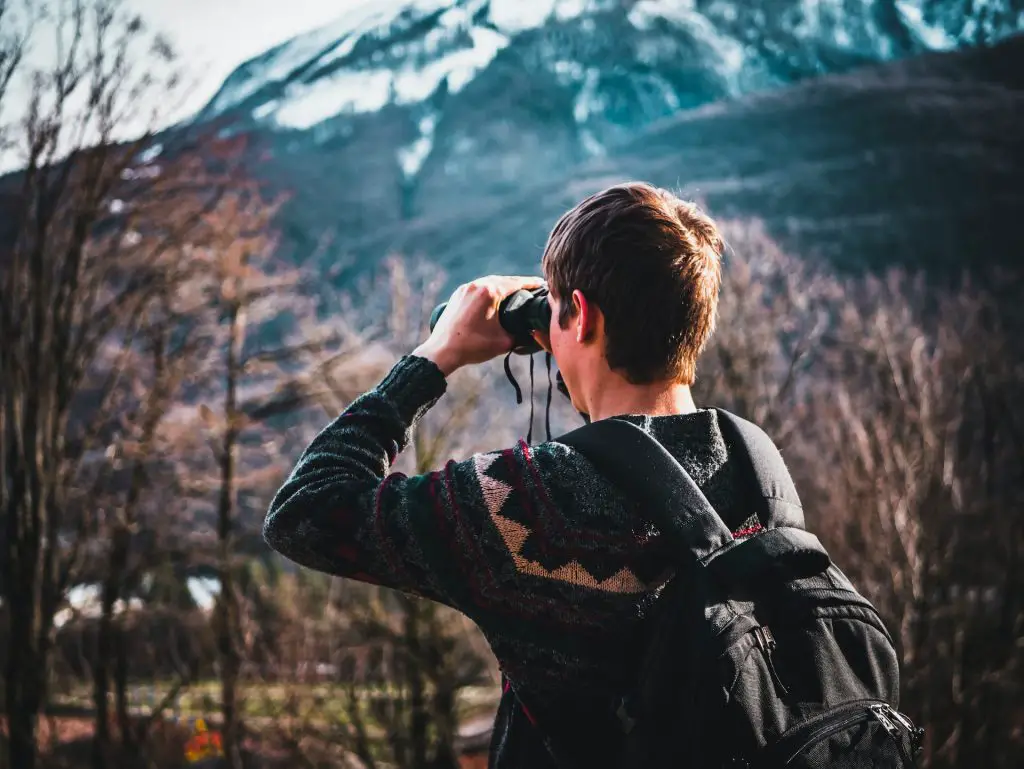
Nature Photography
Nature photography allows us to capture the beauty and intricacies of the natural world.
Binoculars can serve as valuable tools for enhancing the practice of nature photography by enabling photographers to scout subjects, observe details, and plan compositions from a distance.
They offer a closer look at wildlife, distant landscapes, and intricate natural elements, assisting photographers in capturing stunning and captivating images.
Subjects and details to capture through binoculars
Binoculars provide photographers with the ability to focus on subjects and details that might be challenging to observe with the naked eye.
Here are some subjects and details that can be captured through binoculars in nature photography:
- Wildlife: Binoculars allow photographers to observe and study wildlife behavior without causing disturbance. This helps in identifying animal movement patterns, tracking rare or elusive species, and capturing intimate moments from a safe distance.
- Birds: Binoculars enable photographers to observe and identify bird species, study their feeding habits, and observe their nests or courtship displays. This information can be valuable for capturing unique bird photographs in their natural habitats.
- Landscapes: Binoculars offer the opportunity to scout and plan landscape compositions, identifying interesting features, such as rock formations, water bodies, or specific lighting conditions. They help photographers visualize potential images and explore compositions from afar.
- Macro Photography: Binoculars can assist in macro photography by allowing photographers to observe and focus on small details, such as intricate patterns on flowers, the texture of tree bark, or the delicate structure of insects. This enables photographers to plan their approach and capture close-up shots with precision.
Binocular Features for nature photography
When selecting binoculars for nature photography, several features are beneficial to consider. Here are some key features that are particularly useful for this purpose:
- Magnification and Objective Lens Diameter: Opt for binoculars with moderate magnification, typically between 8x and 10x, to balance stability and field of view. A larger objective lens diameter, such as 42mm, ensures sufficient light-gathering capabilities for brighter and clearer images.
- Close Focus Distance: Look for binoculars with a close focus distance that allows you to observe subjects at a closer range. This is especially important for capturing intricate details in macro photography or studying small wildlife.
- Image Quality: Consider binoculars with high-quality optics, such as multi-coated lenses and phase-corrected prisms, to ensure sharp, vibrant, and color-accurate images. Superior image quality contributes to capturing the finest details in nature photography.
- Durability and Portability: Choose binoculars that are lightweight, compact, and built to withstand outdoor conditions. Nature photographers often venture into diverse environments, so durable and portable binoculars ensure long-lasting performance in various weather conditions.
One highly recommended binocular for nature photography is the Swarovski Optik EL 10×42 Binoculars.
These binoculars offer exceptional optical performance and durability, making them ideal for nature photographers.

Landscape and Scenic Views
Binoculars offer a unique perspective for appreciating the beauty of landscapes and scenic views.
They allow us to immerse ourselves in the details of distant vistas, enhancing our connection with nature and providing a more immersive experience.
Whether you’re exploring majestic mountain ranges, hiking in the countryside, gazing at sprawling valleys, or admiring iconic landmarks, binoculars bring the landscapes to life, revealing hidden details and enriching our understanding of the natural world.
Spectacular landscapes and landmarks to observe
Binoculars open up a world of breathtaking landscapes and iconic landmarks to explore in greater detail. Here are some notable examples:
- Mountain Ranges: Binoculars reveal the intricacies of towering peaks, snow-capped mountains, and the rugged terrain of mountain ranges like the Himalayas, the Rockies, or the Alps. You can observe the textures of cliffs, the flow of glaciers, and the majesty of distant summits.
- Coastal Scenery: Binoculars bring coastal scenery to life, allowing you to witness the crashing waves, rocky cliffs, and vast expanses of ocean. You can observe seabirds in flight, spot distant lighthouses, and appreciate the interplay between land and sea.
- National Parks: Binoculars enable you to explore the wonders of national parks, such as the Grand Canyon, Yellowstone, or Serengeti. You can observe wildlife in their natural habitats, study the intricacies of geological formations, and witness the harmony of diverse ecosystems.
- Iconic Landmarks: Binoculars help you appreciate iconic landmarks like the Eiffel Tower, the Great Wall of China, or the Statue of Liberty, even from a distance. You can observe architectural details, spot people enjoying the surroundings, and capture the grandeur of these famous structures.
Techniques for observing distant landscapes with binoculars
Observing distant landscapes with binoculars requires specific techniques to enhance your experience. Here are some tips to make the most of your binoculars:
- Steady Your Hands: To minimize hand shake and achieve a steadier view, rest your elbows on a stable surface, such as a railing or tripod. This helps reduce movement and allows for a clearer image.
- Scan the Horizon: Start by scanning the horizon with your binoculars, panning slowly from left to right or vice versa. This allows you to identify interesting features, landmarks, or wildlife that may catch your attention.
- Adjust the Focus: Use the focus wheel on your binoculars to fine-tune the focus for the desired depth of field. Experiment with different settings to bring both nearby and distant elements into sharp focus.
- Take Your Time: Spend time observing and exploring the landscape through your binoculars. Look for intricate details, patterns, or unique formations that may not be immediately apparent at first glance.
Capturing stunning photos with binoculars
Binoculars can also serve as tools for capturing stunning photos of landscapes and scenic views. Here are some tips for using binoculars in your photography:
- Use a Smartphone Adapter: Many binoculars offer smartphone adapters that allow you to attach your phone’s camera to the binoculars. This enables you to capture photos through the binoculars, using them as a telephoto lens.
- Stabilize the Binoculars: To minimize camera shake when taking photos through the binoculars, stabilize them by resting them on a solid surface or using a tripod. This helps ensure sharp and clear images.
- Experiment with Zoom: If your binoculars have zoom capabilities, experiment with different magnification settings to capture various perspectives and compositions of the landscape.
- Pay Attention to Lighting: Consider the lighting conditions and how they affect the landscape. Capture photos during golden hours, when the soft light enhances the beauty of the scenery.
One highly recommended binocular for landscape and scenic views is the Vortex Optics Diamondback HD 10×42 Binoculars.
These binoculars offer exceptional optical performance and durability, making them ideal for capturing stunning views.
Getting Started with Your Binoculars: A Simple Guide
So, you’ve got a pair of binoculars and you’re ready to start on your exciting journey of exploration. Here are some simple steps to help you get started:
Familiarize Yourself with Your Binoculars:
Take a moment to examine your binoculars and get acquainted with their features.
Identify the focus wheel, which allows you to adjust the sharpness of the image, and the eyecups, which can be adjusted to fit your eyes comfortably.
Adjust the Eyecups:
If you wear glasses, twist the eyecups to their extended position.
If you don’t wear glasses, keep the eyecups in the down position. This ensures that your eyes are at the correct distance from the binoculars for a clear view.
Adjust the Interpupillary Distance:
Locate the hinge between the two barrels of the binoculars.
Hold the binoculars with one hand and use your other hand to adjust the distance between the barrels until you see a single circular image. This aligns the binoculars with your eyes.
Set the Diopter Adjustment:
Many binoculars have a diopter adjustment, usually located on the right eyepiece.
Look through the binoculars with your right eye closed and use the diopter adjustment to focus the image in your left eye.
Then switch and do the same for your right eye. This ensures that both eyes have clear vision.
Practice Focusing:
Choose a distant object, such as a tree or a building, and look through your binoculars.
Use the focus wheel to adjust the sharpness of the image until it appears clear and detailed.
Practice focusing on different objects at various distances to become comfortable with the process.
Start Exploring:
Once you feel confident with focusing, it’s time to venture out and start exploring!
Choose an activity that interests you, such as bird watching, wildlife observation, or scenic views, and take your binoculars with you.
Be patient and observant, scanning your surroundings and allowing your binoculars to reveal hidden details and exciting sights.
Take Note of What You See:
As you use your binoculars, make a mental or physical note of the interesting things you observe.
It could be the vibrant colors of a bird’s feathers, the intricate patterns on a butterfly’s wings, or the breathtaking view of a sunset over the mountains.
This helps you develop your observation skills and creates lasting memories of your experiences.
Remember, practice makes perfect. The more you use your binoculars, the more comfortable and skilled you’ll become at focusing, tracking objects, and immersing yourself in the wonders of the world around you.
More Reads: Choosing Binoculars: Complete Guide
